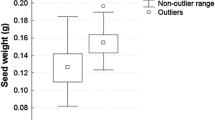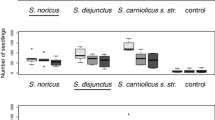Abstract
Many studies have compared the growth of plants from native and invasive populations, but few have considered the role of ploidy. In its native range in North America, Solidago gigantea Aiton (Asteraceae) occurs as a diploid, tetraploid and hexaploid, with considerable habitat differentiation and geographic separation amongst these ploidy levels. In the introduced range in Europe, however, only tetraploid populations are known. We investigated the growth performance and life history characteristics of plants from 12 European and 24 North American (12 diploid, 12 tetraploid) populations in a common garden experiment involving two nutrient and two calcium treatments. Twelve plants per population were grown in pots for two seasons. We measured 24 traits related to leaf nutrients, plant size, biomass production and phenology as well as sexual and vegetative reproduction. Native diploid plants had a higher specific leaf area and higher leaf nutrient concentrations than native tetraploids, but tetraploids produced many more shoots and rhizomes. Diploids grown with additional calcium produced less biomass, whereas tetraploids were not affected. European plants were less likely to flower and produced smaller capitulescences than North American tetraploids, but biomass production and shoot and rhizome number did not differ. We conclude that a knowledge of ploidy level is essential in comparative studies of invasive and native populations. While clonal growth is important for the invasion success of tetraploid S. gigantea, its potential was not acquired by adaptation after introduction but by evolutionary processes in the native range.



Similar content being viewed by others
References
Baack EJ, Stanton ML (2005) Ecological factors influencing tetraploid speciation in snow buttercups (Ranunculus adoneus): niche differentiation and tetraploid establishment. Evolution 59:1936–1944
Bastlova D, Cizkova H, Bastl M, Kvet J (2004) Growth of Lythrum salicaria and Phragmites australis plants originating from a wide geographical area: response to nutrient and water supply. Glob Ecol Biogeogr 13:259–271
Blossey B, Notzold R (1995) Evolution of increased competitive ability in invasive nonindigenous plants—a hypothesis. J Ecol 83:887–889
Blumenthal DM, Hufbauer RA (2007) Increased plant size in exotic populations: A common-garden test with 14 invasive species. Ecology 88:2758–2765
Bossdorf O, Auge H, Lafuma L, Rogers WE, Siemann E, Prati D (2005) Phenotypic and genetic differentiation between native and introduced plant populations. Oecologia 144:1–11
Bretagnolle F, Thompson JD (1996) An experimental study of ecological differences in winter growth between sympatric diploid and autotetraploid Dactylis glomerata. J Ecol 84:343–351
Broennimann O, Treier UA, Müller-Schärer H, Thuiller W, Peterson AT, Guisan A (2007) Evidence of climatic niche shift during biological invasion. Ecol Lett 10:701–709
Callaway RM, Ridenour WM (2004) Novel weapons: invasive success and the evolution of increased competitive ability. Front Ecol Environ 2:436–443
Chapuis-Lardy L, Vanderhoeven S, Dassonville N, Koutika LS, Meerts P (2006) Effect of the exotic invasive plant Solidago gigantea on soil phosphorus status. Biol Fertil Soils 42:481–489
Colautti RI, Ricciardi A, Grigorovich IA, MacIsaac HJ (2004) Is invasion success explained by the enemy release hypothesis? Ecol Lett 7:721–733
Daehler CC (2003) Performance comparisons of co-occurring native and alien invasive plants: Implications for conservation and restoration. Annu Rev Ecol Evol S 34:183–211
DeWalt SJ, Denslow JS, Hamrick JL (2004) Biomass allocation, growth, and photosynthesis of genotypes from native and introduced ranges of the tropical shrub Clidemia hirta. Oecologia 138:521–531
Dlugosch KM, Parker IM (2008) Founding events in species invasions: genetic variation, adaptive evolution, and the role of multiple introductions. Mol Ecol 17:431–449
Ehrenfeld JG (2003) Effects of exotic plant invasions on soil nutrient cycling processes. Ecosystems 6:503–523
Ellstrand NC, Schierenbeck KA (2000) Hybridization as a stimulus for the evolution of invasiveness in plants? Proc Natl Acad Sci USA 97:7043–7050
Garnier E, Shipley B, Roumet C, Laurent G (2001) A standardized protocol for the determination of specific leaf area and leaf dry matter content. Funct Ecol 15:688–695
Güsewell S (2004) N:P ratios in terrestrial plants: variation and functional significance. New Phytol 164:243–266
Güsewell S (2005) Responses of wetland graminoids to the relative supply of nitrogen and phosphorus. Plant Ecol 176:35–55
Güsewell S, Zuberbühler N, Clerc C (2005) Distribution and functional traits of Solidago gigantea in a Swiss lakeshore wetland. Bot Helvetica 115:63–75
Güsewell S, Jakobs G, Weber E (2006) Native and introduced populations of Solidago gigantea differ in shoot production but not in leaf traits or litter decomposition. Funct Ecol 20:575–584
Halverson K, Heard SB, Nason JD, Stireman JO (2008) Differential attack on diploid, tetraploid, and hexaploid Solidago altissima L. by five insect gallmakers. Oecologia 154:755–761
Hierro JL, Maron JL, Callaway RM (2005) A biogeographical approach to plant invasions: the importance of studying exotics in their introduced and native range. J Ecol 93:5–15
Hooftman DAP, Oostermeijer JGB, den Nijs JCM (2006) Invasive behaviour of Lactuca serriola (Asteraceae) in the Netherlands: Spatial distribution and ecological amplitude. Basic Appl Ecol 7:507–519
Hull-Sanders HM, Clare R, Johnson RH, Meyer GA (2007) Evaluation of the evolution of increased competitive ability (EICA) hypothesis: Loss of defense against generalist but not specialist herbivores. J Chem Ecol 33:781–799
Hunt J (1982) Dilute hydrochloric acid extraction of plant material for routine cation analysis. Commun Soil Sci Plant Anal 13:49–55
Jakobs G, Weber E, Edwards PJ (2004) Introduced plants of the invasive Solidago gigantea (Asteraceae) are larger and grow denser than conspecifics in the native range. Divers Distrib 10:11–19
Johnson RH, Hull-Sanders HM, Meyer GA (2007) Comparison of foliar terpenes between native and invasive Solidago gigantea. Biochem Syst Ecol 35:821–830
Koutika LS, Vanderhoeven S, Chapuis-Lardy L, Dassonville N, Meerts P (2007) Assessment of changes in soil organic matter after invasion by exotic plant species. Biol Fertil Soils 44:331–341
Lu BB, Ding RX, Zhang L, Yu XJ, Huang BB, Chen WS (2006) Molecular cloning and characterization of a novel calcium-dependent protein kinase gene IiCPK2 responsive to polyploidy from tetraploid Isatis indigotica. J Biochem Mol Biol 39:607–617
Maceira NO, Jacquard P, Lumaret R (1993) Competition between diploid and derivative autotetraploid Dactylis glomerata L. from Galicia—implications for the establishment of novel polyploid populations. New Phytol 124:321–328
Maron JL, Vila M, Bommarco R, Elmendorf S, Beardsley P (2004) Rapid evolution of an invasive plant. Ecol Monogr 74:261–280
McKenney JL, Cripps MG, Price WJ, Hinz HL, Schwarzlander M (2007) No difference in competitive ability between invasive North American and native European Lepidium draba populations. Plant Ecol 193:293–303
Melville MR, Morton JK (1982) A biosystematic study of the Solidago canadensis (Compositae) complex. 1. The Ontario populations. Can J Bot 60:976–997
Meyer GA, Hull-Sanders HM (2008) Altered patterns of growth, physiology and reproduction in invasive genotypes of Solidago gigantea (Asteraceae). Biol Invas 10:303–317
Meyer G, Clare R, Weber E (2005) An experimental test of the evolution of increased competitive ability hypothesis in goldenrod, Solidago gigantea. Oecologia 144:299–307
Müller H (1989) Growth pattern of diploid and tetraploid spotted knapweed, Centaurea maculosa Lam. (Compositae), and effects of the root mining moth Agapeta zoegana (L.) (Lep.: Cochylidae). Weed Res 29:103–111
Müller-Schärer H, Schaffner U, Steinger T (2004) Evolution in invasive plants: implications for biological control. Trends Ecol Evol 19:417–422
Münzbergova Z (2006) Ploidy level interacts with population size and habitat conditions to determine the degree of herbivory damage in plant populations. Oikos 115:443–452
Münzbergova Z (2007) No effect of ploidy level in plant response to competition in a common garden experiment. Biol J Linnean Soc 92:211–219
Petit C, Thompson JD (1997) Variation in phenotypic response to light availability between diploid and tetraploid populations of the perennial grass Arrhenatherum elatius from open and woodland sites. J Ecol 85:657–667
Reich PB, Ellsworth DS, Walters MB, Vose JM, Gresham C, Volin JC, Bowman WD (1999) Generality of leaf trait relationships: A test across six biomes. Ecology 80:1955–1969
Rice WR (1989) Analyzing tables of statistical tests. Evolution 43:223–225
Roach DA, Wulff RD (1987) Maternal effects in plants. Annu Rev Ecol Syst 18:209–235
Schlaepfer DR (2008) Ecological significance of ploidy level of native and invasive populations of Solidago gigantea. PhD thesis no. 17677. ETH, Zurich. Available at: http://e-collection.ethbib.ethz.ch/view/eth:30868
Schlaepfer DR, Edwards PJ, Semple JC, Billeter R (2008a) Cytogeography of Solidago gigantea (Asteraceae) and its invasive ploidy level. J Biogeogr 35:2119–2127
Schlaepfer DR, Edwards PJ, Widmer A, Billeter R (2008b) Phylogeography of native ploidy levels and invasive tetraploids of Solidago gigantea (Asteraceae). Mol Ecol 17:5245–5256
Semple JC, Cook RE (2006) Solidago. In: Flora of North America Editorial Committee (ed) Flora of North America North of Mexico, vol 20. Magnoliophyta: Asteridae, part 7: Asteraceae, part 2: Asterales, part 2. Oxford University Press, Oxford/New York, pp 107-166
Shipley B, Vile D, Garnier E, Wright IJ, Poorter H (2005) Functional linkages between leaf traits and net photosynthetic rate: reconciling empirical and mechanistic models. Funct Ecol 19:602–615
Theoharides KA, Dukes JS (2007) Plant invasion across space and time: factors affecting nonindigenous species success during four stages of invasion. New Phytol 176:256–273
Vanderhoeven S, Dassonville N, Meerts P (2005) Increased topsoil mineral nutrient concentrations under exotic invasive plants in Belgium. Plant Soil 275:169–179
Vanderhoeven S, Dassonville N, Chapuis-Lardy L, Hayez M, Meerts P (2006) Impact of the invasive alien plant Solidago gigantea on primary productivity, plant nutrient content and soil mineral nutrient concentrations. Plant Soil 286:259–268
Weber E, Jakobs G (2005) Biological flora of central Europe: Solidago gigantea Aiton. Flora 200:109–118
Weber E, Schmid B (1993) Das Neophytenproblem. Diss Bot 196:209–227
Weber E, Schmid B (1998) Latitudinal population differentiation in two species of Solidago (Asteraceae) introduced into Europe. Am J Bot 85:1110–1121
Yang RY, Mei LX, Tang JJ, Chen X (2007) Allelopathic effects of invasive Solidago canadensis L. on germination and growth of native Chinese plant species. Allelopathy J 19:241–247
Zar JH (1999) Biostatistical analysis, 4th edn. Prentice Hall, Upper Saddle River
Zhang Q, Yao LJ, Yang RY, Yang XY, Tang JJ, Chen X (2007) Potential allelopathic effects of an invasive species Solidago canadensis on the mycorrhizae of native plant species. Allelopathy J 20:71–77
Acknowledgments
We thank Sabine Güsewell for statistical advice, Martin Fotsch for help with the experiment, Philipp Streckeisen for his efforts in the greenhouse (FAL, Reckenholz, Switzerland), Andreas Wolf for measuring leaf traits and Rose Trachsler for nutrient analyses. We also thank Jake Alexander, Daniela Eichenberger, Harry Eggenschwiler, Min Hahn, Edith Lang, Myriam Poll, Carmen Rothenbühler, Rodolphe Schlaepfer and Mila Trtiková for help during the harvest. The project is funded by the grant 0-20259-05 from the ETH Zurich, Switzerland. The experiments comply with the current laws of the country in which they were performed.
Author information
Authors and Affiliations
Corresponding author
Additional information
Communicated by Melinda Smith.
Electronic supplementary material
Below is the link to the electronic supplementary material.
Rights and permissions
About this article
Cite this article
Schlaepfer, D.R., Edwards, P.J. & Billeter, R. Why only tetraploid Solidago gigantea (Asteraceae) became invasive: a common garden comparison of ploidy levels. Oecologia 163, 661–673 (2010). https://doi.org/10.1007/s00442-010-1595-3
Received:
Accepted:
Published:
Issue Date:
DOI: https://doi.org/10.1007/s00442-010-1595-3




